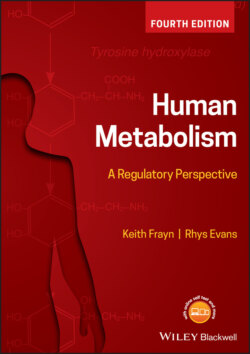Читать книгу Human Metabolism - Keith N. Frayn - Страница 23
1.2.2.3 Proteins
ОглавлениеProteins are chains of amino acids linked through peptide bonds. Individual proteins are distinguished by the number and order of amino acids in the chain – the sequence, or primary structure. Within its normal environment, the chain of amino acids will assume a folded, three-dimensional shape, representing the secondary structure (local folding into α-helix and β-sheet) and tertiary structure (folding of the complete chain on itself). Two or more such folded peptide chains may then aggregate (quaternary structure) to form a complete enzyme or other functional protein.
In terms of energy metabolism, the first aspect we shall consider is not how this beautiful and complex arrangement is brought about; we shall consider how it is destroyed. Protein in food is usually denatured (its higher-order structures disrupted) by cooking or other treatment, and then within the intestinal tract the disrupted chains are broken down to short lengths of amino acids before absorption into the bloodstream. Within the bloodstream and within tissues we shall be concerned with the transport and distribution of individual amino acids. These are mostly sufficiently water soluble to circulate freely in the aqueous environment of the plasma. Only tryptophan is sufficiently hydrophobic to require a transporter; it is bound loosely (like the NEFAs) to albumin. Amino acids, not surprisingly, do not cross cell membranes by simple diffusion; there are specific transporters, carrying particular groups of amino acids (Chapter 2, Table 2.2).
Protein is often considered as the structural material of the body, although it should not be thought of as the only structural material; it can only assume this function because of the complex arrangements of other cellular constituents, especially phospholipids forming cell membranes. Nevertheless, apart from water, protein is the largest single component in terms of mass of most tissues.1 Within the body, the majority of protein is present in the skeletal muscles, mainly because of their sheer weight (around 40% of the body weight) but also because each muscle cell is well packed with the proteins (actin and myosin) which constitute the contractile apparatus. But it is important to remember that most proteins act in an aqueous environment and are, therefore, associated with water. This is relevant if we consider the body’s protein reserves as a form of stored chemical energy. Since protein is associated with water, it suffers the same drawback as a form of energy storage as does glycogen; with every gram of protein are associated about 3g of water. It is not an energy-dense storage medium. Further, although protein undoubtedly represents a large source of energy that is drawn upon during starvation, it should be remembered that there is, in animals, no specific storage form of protein; all proteins have some function other than storage of energy. Thus, utilisation of protein as an energy source involves loss of the substance of the body. In evolutionary terms we might expect that this will be minimised (i.e. the use of the specific storage compounds glycogen and triacylglycerol will be favoured) and, as we shall see in later chapters, this is exactly the case.
The monomers from which proteins are made, amino acids, have important chemical characteristics which endow them with the properties that make them ideal for assembling into a peptide chain. They comprise a central (‘α’) carbon, with characteristic chemical groups attached to its four valencies: an amino (NH2) group, a carboxyl (COOH) group, a hydrogen atom, and finally a variable (‘R’) group which defines the actual amino acid species (for example, if R = a methyl group, CH3, then the resulting amino acid is alanine), illustrated in Figure 1.11. At acid pH, the amino group is ionised (NH3+) whilst at alkaline pH the carboxyl group is ionised (COO−); at physiological pH (7.4) the amino acid is present as a Zwitter ion (both amino and carboxyl groups ionised). Proteins are assembled by adjacent amino acids forming a peptide bond between the carboxyl group of one and the amino group of another. This always leaves a terminal amino group and a terminal carboxyl group on any protein, hence all proteins act as buffers, able to gain or lose a proton. The carbon ‘backbone’ of individual amino acids is relatively energy rich and can be oxidised to yield energy once the amino group has been removed.
Figure 1.11 Structure of an amino acid. At physiological pH (7.4) the carboxyl group is ionised to COO− and the amino group to NH3+. The nature of the ‘R’ group, or side-chain, defines the particular amino acid: the 20 different amino acids which constitute proteins each have a different R group.
